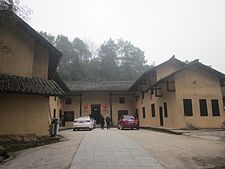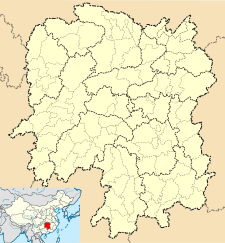Former Residence of Xie Juezai
| Former Residence of Xie juezai | |
|---|---|
谢觉哉故居 | |
 Former Residence of Xie Juezai. | |
| General information | |
| Type | Traditional folk houses |
| Location | Shatian Township, Ningxiang County, Hunan |
| Country | China |
| Coordinates | 28°04′58″N 112°03′32″E / 28.08287°N 112.058779°E |
| Completed | 1821 |
| Opened | 2004 |
| Technical details | |
| Floor area | 740 m2 (8,000 sq ft) |
The Former Residence of Xie juezai or Xie Juezai's Former Residence (simplified Chinese: 谢觉哉故居; traditional Chinese: 謝覺哉故居; pinyin: Xiè Juézaī Gùjū) was the birthplace and childhood home of Xie Juezai, a Chinese politician who served as the President of the Supreme People's Court from 1959 to 1965.[1] The residence is located in Shatian Township, Ningxiang County, Hunan, approximately 70-kilometre (43 mi) from the county seat.[2][3] It covers an area of 2,100 m2 (23,000 sq ft) and a building area of 740 m2 (8,000 sq ft),[2] comprises buildings such as main room, living room, kitchen, and bedroom.[4]
History
[edit]The residence was built by Xie Juezai's ancestors in the 1st Year of Daoguang Emperor (1821–1850) in the Qing dynasty (1644–1911), namely 1821.[1]
On April 26, 1883, in the ruling of Guangxu Emperor (1875–1908), Xie Juezai was born in here.[1][5]
In 1997 it was listed as a Municipality-level Patriotic Education Base by the Propaganda Department of the Changsha Municipal Government.
In August 2000 it was classified as a Municipality Protected Historic Site.
On May 19, 2002, it was designated as a provincial level key cultural heritage.
In April 2004, during the 100th anniversary of the birth of Xie Juezai, the Government of Ningxiang renovated the residence and then it was officially opened to the public.
In 2013 it was listed as a "Historical and Cultural Sites Protected at the Provincial Level".[5]
Access
[edit]The Former Residence of Xie Juezai open to visitors for free.
Surrounding area
[edit]Nearby attractions include the Former Residence of He Shuheng.
Gallery
[edit]References
[edit]- ^ a b c Huang Haichao & Jiang Hongzhao (2002), p. 49.
- ^ a b Sun Binli (2016-11-14). 【首届湖南文物解读大赛】谢觉哉故居解说词. rednet (in Chinese).
- ^ 谢觉哉故居展示利用工程立项获国家文物局批准. 163.com (in Chinese). 2016-02-01.
- ^ 探访长沙红色地标之十:谢觉哉故居. changsha.cn (in Chinese). 2016-07-06. Archived from the original on 2017-02-27. Retrieved 2017-02-27.
- ^ a b Wang Xijia (2014), p. 21.
Bibliography
[edit]- Huang Haichao; Jiang Hongzhao (2002). 宁乡史地 [History and Geography of Ningxiang] (in Chinese). Hainan: South China Publishing House. ISBN 7-80660-538-X.
- Wang Xijia (2014). 长沙史话 [A Brief History of Changsha] (in Chinese). Beijing: Social Sciences Academic Press. ISBN 978-7-5097-6662-0.




